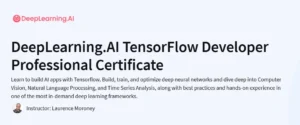What will you learn in Data Science for Non-Programmers Course
Grasp core data science concepts—statistics, probability, and data storytelling—without coding
Perform Exploratory Data Analysis (EDA) using no-code tools and spreadsheets
Build predictive models with visual, drag-and-drop interfaces
Visualize data effectively through charts, dashboards, and infographics
Translate data insights into actionable business recommendations
Program Overview
Module 1: Introduction to Data Science
⏳ 1 week
Topics: Data science lifecycle, problem framing, key terminology
Hands-on: Define a business problem and outline a data-driven solution approach
Module 2: Data Wrangling & Cleaning
⏳ 1 week
Topics: Handling missing values, outlier detection, normalization
Hands-on: Clean a sample dataset in Excel or Google Sheets using built-in functions
Module 3: Exploratory Data Analysis
⏳ 1 week
Topics: Summary statistics, pivot tables, chart selection best practices
Hands-on: Use spreadsheet pivot tables and charts to surface trends and anomalies
Module 4: Visual Analytics & Dashboarding
⏳ 1 week
Topics: Principles of visual design, interactive dashboards, storytelling with data
Hands-on: Build a dashboard in Google Data Studio or Microsoft Power BI’s no-code interface
Module 5: No-Code Predictive Modeling
⏳ 1 week
Topics: Regression vs. classification, model evaluation metrics, overfitting
- Hands-on: Train and evaluate models in a no-code tool like RapidMiner or Orange
Module 6: Communicating Insights & Recommendations
⏳ 1 week
Topics: Crafting narratives, slide deck design, stakeholder presentation skills
Hands-on: Prepare a short report and presentation summarizing key findings
Get certificate
Job Outlook
Demand for data-literate professionals is soaring across industries—healthcare, finance, retail, and government
Roles suited: Business Analyst, Marketing Analyst, Operations Specialist with data skills
Typical salaries range from $60,000 to $95,000+ depending on industry and geo
Non-programmers with data science acumen bridge the gap between technical teams and business stakeholders
Specification: Data Science for Non-Programmers Course
|
FAQs
- No programming knowledge is required; the course uses no-code tools like Excel, Data Studio, and RapidMiner.
- Concepts such as statistics, probability, and data storytelling are explained in plain language.
- Hands-on labs provide practical experience using drag-and-drop interfaces.
- Learners can build predictive models and dashboards without writing code.
- Skills gained are transferable to real-world business analytics tasks.
- Hands-on exercises cover cleaning datasets, handling missing values, and detecting outliers.
- Exploratory Data Analysis (EDA) is conducted using spreadsheets and pivot tables.
- Dashboard creation and visual storytelling are taught with no-code tools.
- Capstone projects simulate end-to-end analysis for business problems.
- Learners gain skills to deliver actionable insights for stakeholders.
- Capstone projects and exercises form portfolio-ready pieces.
- Emphasis on storytelling with data helps communicate insights effectively.
- Skills in no-code predictive modeling are valued across industries.
- Learners can apply analytics skills in finance, healthcare, retail, and operations.
- Portfolio and practical experience increase job and freelance opportunities.
- Basic regression and classification models are taught using no-code tools.
- Focus is on understanding model results and metrics like accuracy and overfitting.
- Hands-on labs allow students to train, test, and evaluate models visually.
- Advanced ML techniques and deep learning are not included.
- Learners can pursue advanced analytics courses after building a strong foundation.
- Allocate 3–5 hours per week to complete modules and hands-on exercises.
- Focus on one module or topic per session to reinforce understanding.
- Document workflows, dashboards, and model outputs for reference.
- Complete capstone and mini-projects incrementally to track progress.
- Engage with online forums or study communities for guidance and feedback.





